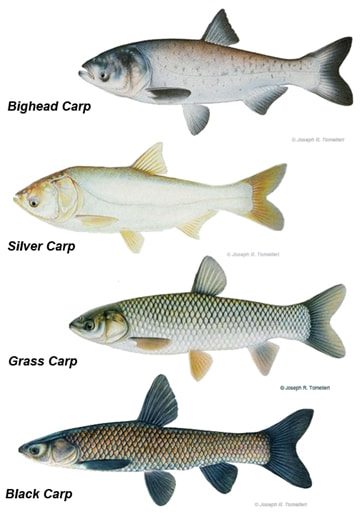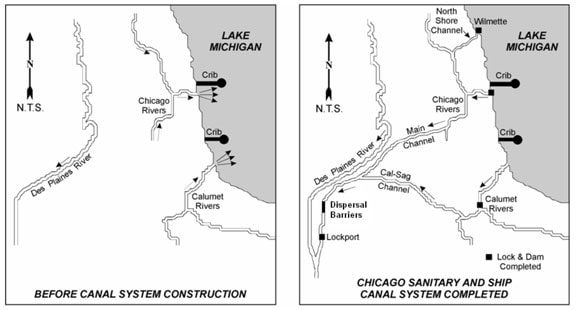Invasive Carp
Invasive carp are a tremendous threat to the Great Lakes and could devastate the lakes if they enter our Great Lakes ecosystem. The invasive carp includes four species: black carp, grass carp, bighead carp, and silver carp.

Originally, invasive carp were introduced to the United States as a management tool for aqua culture farms and sewage treatment facilities. The carp have made their way north to the Illinois River after escaping from fish farms during massive flooding along the Mississippi River.
Due to their large size, ravenous appetite, and rapid rate of reproduction, invasive carp pose a significant threat to the Great Lakes ecosystem by consuming large quantities of phytoplankton and competing with native fish for habitat. Steadily, the carp have become the most abundant species in some areas of the Mississippi, out-competing native fish. Invasive carp can grow to an average of four feet and 100 pounds, and can consume up to 20 percent of their body weight in plankton per day. Carp have shown an affinity for becoming the dominant large fish species over more desirable native species or established fish that are recreationally and economically important. Invasive carp aggressively out-compete and eventually displace native fish altogether. With no natural predators and the ability to produce 2.2 million eggs, the invasive carp could devastate the Great Lakes’ multibillion dollar fishing industry. In addition to the threat invasive carp pose to Great Lakes fisheries, carp also pose an actual physical threat to boaters. The silver species of invasive carp can leap out of the water creating a hazard for boaters and water-skiers as the fish crash into boats, hitting people and damaging equipment.
The Chicago Ship and Sanitary Canal connects the Mississippi River to the Great Lakes.
Before and After of the Chicago Sanitary & Shipping Canal
Credit: United States Army Corps of Engineers

In attempt to prevent the invasive carp from entering the Great Lakes, the United States Army Corps of Engineers (USACE) erected a dispersal barrier system on the Chicago Sanitary and Ship Canal. The electric barrier on the canal is designed to repel the carp back from entering Lake Michigan. While the series of electric barriers exist on the waterway, invasive carp have been found on the Lake Michigan side of the electric barriers, most notably in 2017 when a silver carp was found just nine miles from Lake Michigan.
To help prevent the movement of Asian carps from the Mississippi River Basin to the Great Lakes Basin, additional barriers on the Chicago Area Waterways have been proposed at the Brandon Road Lock and Dam as a component of the Great Lakes and Mississippi River Interbasin Study (GLMRIS) Report developed by the U.S. Army Corps of Engineers (USACE).
Brandon Road Lock and Dam near Joliet, Illinois, has been identified as the critical pinch point where layered technologies could be used to prevent movement of invasive carp populations into the Great Lakes. The recommended plan involves a layered system of structural and non-structural control measures. Structural measures include technologies such as a flushing lock, an engineered channel with electric barrier, underwater acoustic deterrent, air bubble curtain and an automated barge clearing deterrent. Non-structural measures, implemented in conjunction with other federal agencies, could include public education and outreach, monitoring, integrated pest management, pesticides, manual or mechanical removal, and research and development.
Congress approved the project – estimated at $830 million – in the December 2020 omnibus bill. The project is currently in the Preconstruction, Engineering, and Design (PED) phase. PED will take three years to complete and cost around $28.8 million. Illinois is the local sponsor for PED, and all nonfederal funds required for PED are secured from Illinois and Michigan. In January 2022, the Biden administration allocated $226 million in funding from the Infrastructure Investment and Jobs Act to the Brandon Road project, fully funding PED as well as the first phase of project construction.
Full Federal Funding is Necessary for the Brandon Road Interbasin Project
Preventing invasive carp from entering the Great Lakes is not solely an Illinois burden to solve economically because the project is located in Illinois. It is very clear that this is a project to protect multiple states in the Great Lakes Basin from a problem that originated and spread through multiple states in the Mississippi River basin. As such, it should receive full federal funding because it is a truly national problem to solve. There is precedent for full funding for similar projects like this. For example, the original electrical barrier project currently operating on the Illinois River just southwest of Chicago to help reduce the risk of invasive carp of transferring into Lake Michigan was and remains a full federal project – meaning all the funding for the construction, maintenance and operation is covered by the federal government.
While this operation is located in Illinois, the state was and remains the non-federal partner, but is not liable for any of the costs associated with the operation. In addition, the recently Congressionally-authorized and appropriated expansion of the Soo Locks located in Sault Ste. Marie, Michigan was a full federal funding project. These locks are a vital transportation hub for commerce – not just for Michigan – but for the entire Great Lakes region, including Canada. Michigan, as the non-federal partner, is not on the hook to cover the billions in cost for this project. We need Congress to change the federal cost share to 100 percent for Brandon Road to ensure there are delay in commencing construction of the project once the preconstruction engineering and design phase is complete that could allow invasive carp the time to invade and establish a population in the Great Lakes.

Invasive Carp – How You Can Help
Don’t move live fish from one location to another.
Never use wild-caught baitfish in waters other than where they came from.
Learn to identify invasive carp and the features that distinguish young carp from gizzard shad and other minnows.
Drain lake or river water from live wells and bilges before leaving any body of water.
Follow all state rules to prevent the spread of aquatic invasive species.
If you think you found an invasive carp, freeze the fish in a sealed plastic bag, note the date and location, and call your local department of natural resources or environmental quality.

